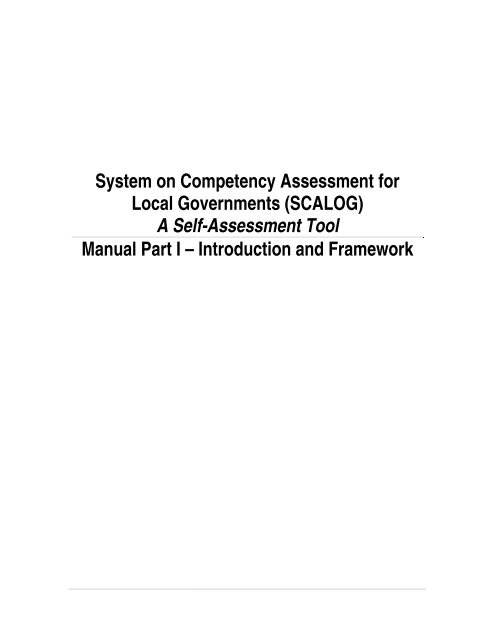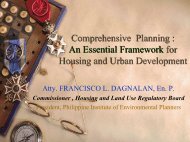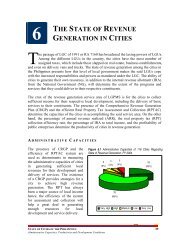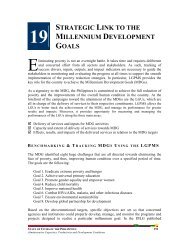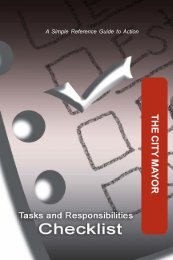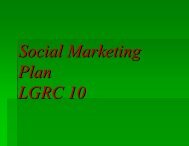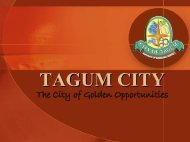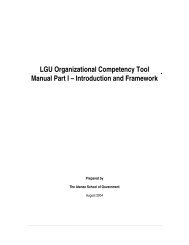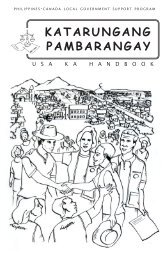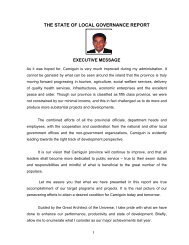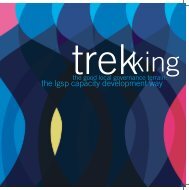SCALOGManual Part I-Intro and Framework7-30.pdf - LGRC DILG 10
SCALOGManual Part I-Intro and Framework7-30.pdf - LGRC DILG 10
SCALOGManual Part I-Intro and Framework7-30.pdf - LGRC DILG 10
Create successful ePaper yourself
Turn your PDF publications into a flip-book with our unique Google optimized e-Paper software.
System on Competency Assessment forLocal Governments (SCALOG)A Self-Assessment ToolManual <strong>Part</strong> I – <strong>Intro</strong>duction <strong>and</strong> Framework
Table of Contents<strong>Intro</strong>duction ....................................................................................................................... 1Purpose ..............................................................................................................................1What are “Organizational Competencies”? ........................................................................1Why are Organizational Competencies important?............................................................2How does the System on Competency Assessment for Local Governments orthe SCALOG Tool relate to the LGPMS framework? .................................................2Organizational Competencies ............................................................................................5About the SCALOG Tool ....................................................................................................7Rating Scale .........................................................................................Error! Bookmarknot defined.Respondents to the Tool ......................................................................8Process for Accomplishing the Tool .....................................................8Scoring <strong>and</strong> Submission.......................................................................9Analysis Framework ...........................................................................................................9
System on Competency Assessment for Local Governments(SCALOG)<strong>Intro</strong>ductionPurposeThe purpose of the System on Competency Assessment for Local Governments (SCALOG), as aself-assessment tool, is to promote continuous improvement in local government units throughthe identification of organizational strengths <strong>and</strong> areas for development that can be addressedthrough capacity building efforts.What are “Organizational Competencies”?Organizational competencies are an integrated set of work processes, structures, systems <strong>and</strong>technologies that a LGU must have to render <strong>and</strong> sustain superior performance. They may alsobe referred to as “institutional or organizational capacity”.Organizational competencies are different from individual competencies. A helpful distinction isshown below:Individual Competency = knowledge + skills + attitude + experienceOrganizational Competency = competent workforce + valid structures + efficientprocesses + effective leadership <strong>and</strong>management style + adequate resources +appropriate technology, tools, facilities +appropriate culture + effectivepolitical/participatory processes.knowledgeexperienceattitudeskillsIndividual Competency1
validstructuresappropriatetechnologyefficientprocessesappropriate cultureadequateresourcesORGAN-IZATIONeffectivepolitical/participatoryeffectiveleadership <strong>and</strong>managementstylecompetentworkforceOrganizational CompetencyAs indicated above, individual competencies are one component of organizational competency<strong>and</strong> manifested in a competent workforce. Other components provide the context that enablegood performance within the organization.Why are Organizational Competencies important?The practice of capacity building for LGUs in the country reveals that individuals are often thefocus of analysis <strong>and</strong> training is often seen as the answer to performance gaps or organizationalchange. We also know from our own experience <strong>and</strong> research findings that training is neitherenough nor always an appropriate response. The problem may not simply be the lack ofcompetent warm bodies but the absence of an organizational environment supportive of goalfocused<strong>and</strong> results-oriented performance. The latter is the main focus of organizationalcompetencies. Organizations <strong>and</strong> individuals do not perform in a vacuum; their ability to carry outtheir assigned responsibilities is deeply affected by the broader context within which they operate,i.e. the structures, processes, systems <strong>and</strong> culture that govern their behavior. Therefore,assessing the organizational competencies of LGUs provides for a broader, more holisticst<strong>and</strong>point in determining capacity improvement needs.How does the System on Competency Assessment for Local Governments or the SCALOGTool relate to the LGPMS framework?The LGPMS measures the inputs <strong>and</strong> outputs/outcomes of LGU performance. The SCALOGmeasures the “throughput” or the capacity of the LGU to transform inputs into outputs <strong>and</strong>outcomes.2
InputsOrganizational Competencies(Throughput)Outputs/OutcomesLGPMS SCALOG LGPMSIn the SCALOG tool, the seven (7) organizational competencies are measured using a 5-pointrating scale of the various performance indicators of the fourteen (14) service areas spread overthe five (5) LGPMS performance areas.The indicators for each of the 14 service areas are classified into two categories: the complianceindicators <strong>and</strong> the best practice indicators. Compliance indicators reflect conformity to the LocalGovernment Code <strong>and</strong> other laws <strong>and</strong> regulations as well as other minimum basic requirementsof LGUs. Best practice indicators on the other h<strong>and</strong> describe ways in which successful LGUsexhibit effective performance.The interrelation among the seven (7) organizational competencies, fourteen (14) service areas<strong>and</strong> the five (5) LGPMS performance areas are shown in the following circular diagram with theorganizational competencies at the center <strong>and</strong> the two concentric rings representing the LGPMSperformance areas broken into the different service areas, with the inner ring for the compliancelevel indicators <strong>and</strong> the outer ring for the best practice indicators:3
DEVELOPMENTNATURALRESOURCEMGT.WASTE MGT. &POLLUTIONCONTROLFINANCIALACCOUNTABILITY(ICS)FA(ACCOUNTINGSYSTEM)AGRICULTURE &FISHERIESDEVELOPMENTPEACE, SECURITY &DISASTERPREPAREDNESSENTERPRISE,BUSINESS &INDUSTRIALPROMOTIONHOUSING &BASICUTILITIESNATURALRESOURCEMGT.ENTERPRISE BUSINESS& INDUSTRIALPROMOTIONAGRICULTURE & FISHERIESDEVELOPMENTAGRICULTURE & FISHERIESDEVELOPMENTPEACE, SECURITY &DISASTER PREPAREDNESSHOUSING & BASICUTILITIESEDUCATIONWASTE MGT. &POLLUTIONCONTROLORGANIZATIONALCOMPETENCIES(each of the 7)HEALTH & NUTRITIONFINANCIALACCOUNTABILITY(ICS)HUMAN RESOURCE MGT.& DEVELOPMENTFA(ACCOUNTING SYSTEM)RESOURCE ALLOCATION& UTILIZATIONFA(PROCUREMENTSYSTEM)LOCAL LEGISLATIONDEVELOPMENTPLANNINGREVENUE GENERATIONFA(PROCUREMENTSYSTEM)REVENUEGENERATIONLOCALLEGISLATIONDEVELOPMENTPLANNINGEDUCATIONRESOURCEALLOCATION &UTILIZATIONHEALTH &NUTRITIONHUMAN RESOURCEMGT. &4
Organizational CompetenciesA general description of the organizational competencies identified in this study is found below.They are more specifically defined in the Guide in terms of indicators per service area. Theindicators when taken together, describe “best practice”.OrganizationalCompetencies1. Organization <strong>and</strong>StaffingMajor IndicatorsPresence of a full-time office or offices, <strong>and</strong> personneldelivering the service. Indicators for this competency include:• Presence of a full-time office attending to this servicearea. (The Local Government Code m<strong>and</strong>ates thecreation of some of these offices.)• The office is staffed with experienced <strong>and</strong> knowledgeableofficials <strong>and</strong> employees who are able to produce themajor outputs expected of that office.Where appropriate, the names of specific Code-m<strong>and</strong>atedorganizations are mentioned in the Specific Guide thataccompanies each service area evaluation.2. Legislative Support<strong>and</strong> other EnablingMechanismsAvailability or presence of legislative support for a servicearea through ordinances <strong>and</strong> resolutions, <strong>and</strong> other enablingmechanisms such as executive orders, offices orders ormemor<strong>and</strong>a, etc. Indicators for this competency may include:• There is a st<strong>and</strong>ing committee in the Sanggunianfocusing on this service area.• There is legislation/executive issuance intended for theservice area.• If not, there is legislation/executive issuance planned orincluded in the Legislative or Executive Agenda.3. Transparency Proactively disclosing information (e.g., study findings,financial reports) that may interest or affect certain sectors orthe general public. Ensuring that LGU activities <strong>and</strong> decisionmakingprocesses are open <strong>and</strong> above board. Presence ofinformation, education <strong>and</strong> communication programs (IEC).Indicators for this competency may include:• The public has access to records of governmenttransactions, contracts <strong>and</strong> other public documents.• The public has access to information on LGU plans <strong>and</strong>programs.• There are public announcements regarding LGU services<strong>and</strong> requirements related to this service area.• The LGU is using the appropriate media to communicatewith its intended audience.5
4. Management Systems Installing processes <strong>and</strong> procedures for planning, developing,implementing, monitoring <strong>and</strong> evaluating programs <strong>and</strong>projects. They include the ability to form linkages with otherLGUs, NGOs, educational/research institutions <strong>and</strong> others formutual cooperation (e.g., in identifying, planning orimplementing projects, sharing resources, etc). Theindicators of this competency may include:• The LGU has a strategic plan for the service.• There is a clear process for initiating projects.• There is a st<strong>and</strong>ard planning process for theseprojects.• There is a st<strong>and</strong>ard process for monitoring theimplementation of these projects.• There is a st<strong>and</strong>ard process for assessing completedprojects.• There is complementation/synergy with other localgovernment programs/services.Complementation/synergy means projectscoordinate/build on each other so that duplication ofefforts or conflicting initiatives are avoided.• The LGU has mutual cooperation agreements orother forms of linkages with other LGUs, NGOs,educational/research institutions, etc., to implementprograms in this service area.5. <strong>Part</strong>icipation Involving various stakeholders in problem identification,needs assessment, <strong>and</strong> in formulation <strong>and</strong> implementinggoals. Stakeholders are individuals or groups who cancontribute to or benefit from the service. The indicators ofthis competency may include:• NGOs/people’s organizations are represented <strong>and</strong>are active members of councils, committees orboards.• There are other forms of LGU-NGO/private sector tieup• There is an accreditation process for NGOs, POs,cooperatives, other development associations.• The LGU uses different forums for stakeholders toraise <strong>and</strong> analyze issues, such as: public hearings,community/ town hall meetings, barangayassemblies, focus-groups <strong>and</strong> other forms of citizenengagement.• The participation of stakeholders has resulted inchanges in the plans/ programs.6. ContinuousImprovement/Innovations<strong>Intro</strong>ducing new or modifying existing work processes/procedures/ approaches to accomplish most with the leastoverall expenditure of time <strong>and</strong> resources. The indicators ofthis competency may include:• The LGU has introduced improvements or innovations inthis service area.• The LGU has applied Information <strong>and</strong> CommunicationTechnology to this service area.6
7. Customer Service .• Streamlining frontline services to make them morecustomer-friendly <strong>and</strong> seeking feedback from customersregarding services• The LGU reviews/evaluates its frontline services toidentify areas for improvement.• The LGU streamlines its frontline services in terms ofreduction in:• processing/transaction time• number of requirements• number of signatories• number of steps• The LGU provides customer service training ororientation to its frontline staff.About the SCALOG ToolThe SCALOG Tool is divided into 14 service area instruments (Annex ___). Each instrument hasthree parts:• <strong>Part</strong> 1: Organizational Competency Assessment Items – This part consists of 14 sectionsrepresenting the service areas of the Local Government Performance ManagementSystem.• <strong>Part</strong> 2: LGU Strengths <strong>and</strong> Opportunities for improvement• <strong>Part</strong> 3: Guide to some items – provides details or explanation on some items of theinstrumentShown below are the five LGPMS performance areas <strong>and</strong> corresponding service areas in whichspecific organizational competencies are identified. The Governance <strong>and</strong> Administrationperformance areas all contribute to towards performance in Social Services, EconomicDevelopment <strong>and</strong> Environmental Management.GovernanceFinancial AccountabilityTransparency<strong>Part</strong>icipationEquityLocal LegislationAdministrationDevelopment PlanningRevenue GenerationResource Allocation <strong>and</strong> UtilizationHuman Resource Management <strong>and</strong>DevelopmentCustomer ServiceSocial ServicesHealth <strong>and</strong> NutritionEducationHousing <strong>and</strong> Basic UtilitiesPeace, Security <strong>and</strong> Disaster PreparednessEconomic DevelopmentAgriculture <strong>and</strong> Fisheries DevelopmentEnterprise, Business <strong>and</strong> Industrial PromotionEnvironmental ManagementNatural Resources ManagementWaste Management <strong>and</strong> Pollution Control7
Respondents to the ToolThe respondents to the instrument include key stakeholders within <strong>and</strong> outside the LGU. Theywill work as a group to develop a collective response to the questions. Each service area mayrequire different respondents as shown in the table below:Service Area Internal Respondents External RespondentsFinancial Accountability Accounting OfficeBudget OfficeTreasurer’s officeAssessor’s officeAuditorrepresentatives of major clientswith financial transactions withthe LGULocal Legislation Local Chief Executive Sectoral representativesSanggunian secretarySanggunian membersDevelopment Planning Planning <strong>and</strong> development Sectoral representativescoordinator/ officeDevelopment CouncilRevenue GenerationTreasurerAssessorPlanning <strong>and</strong> developmentcoordinator/ officeSectoral representativesResource Allocation <strong>and</strong> Budget OfficeSectoral representativesUtilizationPlanning <strong>and</strong> developmentcoordinator/ officeHuman Resource Management<strong>and</strong> DevelopmentAdministratorHuman Resource Heademployee representativesHealth <strong>and</strong> NutritionChief health/nutrition officer Health sector representatives/Local Health BoardpartnersEducationEducation HeadLocal Education BoardEducation sectorrepresentatives/ partnersHousing <strong>and</strong> Basic Utilities Housing/ Urban Poor Action Housing <strong>and</strong> basic utilities sectorOfficerrepresentatives/ partnersLocal Housing BoardPeace, Security <strong>and</strong> Disaster Peace, Security <strong>and</strong> Disaster Peace, security <strong>and</strong> disasterPreparednessPreparedness head/s preparedness sectorrepresentatives/ partnersAgriculture <strong>and</strong> Fisheries Agriculture <strong>and</strong> Fisheries Head/s Agriculture <strong>and</strong> fisheries sectorDevelopmentrepresentatives/ partnersEnterprise, Business <strong>and</strong>Industrial PromotionEnterprise, business <strong>and</strong>industrial promotion head/sBusiness sector representatives/partnersNatural ResourcesNatural resources management Environment sectorManagementhead/srepresentatives/ partnersWaste Management <strong>and</strong>Pollution ControlWaste Management <strong>and</strong>Pollution Control head/sEnvironment sectorrepresentatives/ partnersProcess for Accomplishing the Toolo Tool will be administered by the Administrator in series of focus group sessions with theabove groups of respondentso The respondents will each be provided a copy of the tool. It is advisable that they receivea copy beforeh<strong>and</strong> to enable them to review the items, gather data <strong>and</strong> determine initialratings.o The Administrator facilitates the discussion among the respondents in answering eachitem. Respondents determine collectively whether the competency indicator is present inthe LGU or not.8
ooThe Administrator records the responses.After the focus group, the Administrator determines the competency rating using therating guide in the manual.Scoring <strong>and</strong> Submissiono The Administrator is provided a diskette with an excel spreadsheet in which to encodethe responses. The spreadsheet automatically calculates the average score for eachcompetency.o Submission via email is highly recommended.o Deadline: data must be encoded <strong>and</strong> submitted by the Administrator on or before thescheduled deadline as reflected in the calendar.Analysis FrameworkIndicator RatingsRespondents will rate “m<strong>and</strong>atory” <strong>and</strong> “best practice” indicators under each competency, usingthe following scale:1 2 3 4 5Never Seldom Sometimes Often AlwaysStatement does notapply at all to theStatement rarelyapplies to the LGUStatementoccasionally appliesStatement applies tothe LGU most of theStatement appliesto the LGU everyLGUto the LGU time timeRatings indicate the extent to which the competency indicators are demonstrated by the LGU.Ratings on individual items are averaged to obtain Indicator ratings. These ratings are used tocompute the Competency Scores.Competency Scores <strong>and</strong> Development NeedsThe Administrator uses the rating guide to determine the competency scores. For eachcompetency within a service area, a Competency Score, say for Management Systems, iscomputed by taking the average of the indicator ratings under that competency.Each competency score indicates development or capability-building action needed by the LGU.For Compliance competencies, the scores are interpreted as follows:CompetencyScoreCompetencyLevelDescription1-
ImprovementNeeded toAchieve FullComplianceMajorimprovement inmost areasModerateimprovement –both major <strong>and</strong>minorimprovementneeds arepresentrequirementsMinorimprovement insome areasrequirementsM aintenance ofcurrent levelAt a very high competency level, the LGU can be said to be largely compliant with m<strong>and</strong>atoryrequirements <strong>and</strong> would only require maintenance of its current level of competency. At a highcompetency level, the LGU complies with most m<strong>and</strong>atory requirements but minor developmentmay be required in a few areas to achieve full compliance. At a moderate level of competency,there are both major <strong>and</strong> minor areas for improvement. At a low level of competency, significantimprovement is required in many areas.For Best Practice Competencies, the scores are interpreted as follows:CompetencyScoreCompetencyLevelDescriptionImprovementNeeded toAchieve FullCompliance1-
Appendix AService Area: EducationCompetency ScoresCompetencyAverageRating1 2 3 4 5Organization <strong>and</strong> Staffing 3Legislative Support <strong>and</strong> OtherEnabling Mechanisms3Transparency 3Management Systems 4<strong>Part</strong>icipation 2Continuous Improvement 2Customer Service 3Areas of StrengthManagementSystems• …• …Competencies with Major Development Needs<strong>Part</strong>icipation• …• …Continuous Improvement0• …• …11
Appendix BCompetency: Management SystemsCompetency Scores by Service AreaCompetencyAverageRating1 2 3 4 5Financial Accountability 5Local Legislation 3Development Planning 3Revenue Generation 4Resource Allocation <strong>and</strong>UtilizationHuman ResourceDevelopment <strong>and</strong>Management33Health <strong>and</strong> Nutrition 2Education 4Housing <strong>and</strong> Basic Utilities 2Peace, Security <strong>and</strong> DisasterPreparednessAgriculture <strong>and</strong> FisheriesDevelopmentEnterprise, Business <strong>and</strong>Industrial PromotionNatural ResourcesManagementWaste Management <strong>and</strong>Pollution Control2343312
Service Areas Strong in Management SystemsFinancial Accountability• …• …Enterprise, Business <strong>and</strong> Industrial Promotion• …• …Service Areas Needing Improvement in Management SystemsHealth <strong>and</strong> Nutrition• …• …Housing <strong>and</strong> Basic Utilities• …• …Peace, Security <strong>and</strong> Disaster Preparedness• …• …Etc. …13


